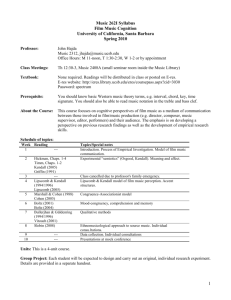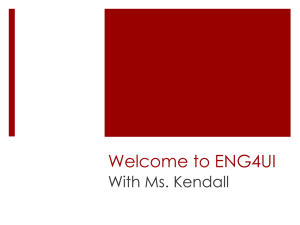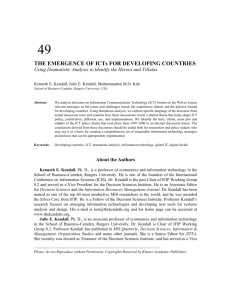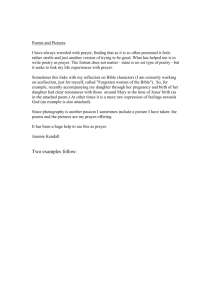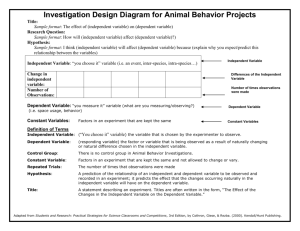Pert 3 Analisis Sistem -Understanding Organizational
advertisement
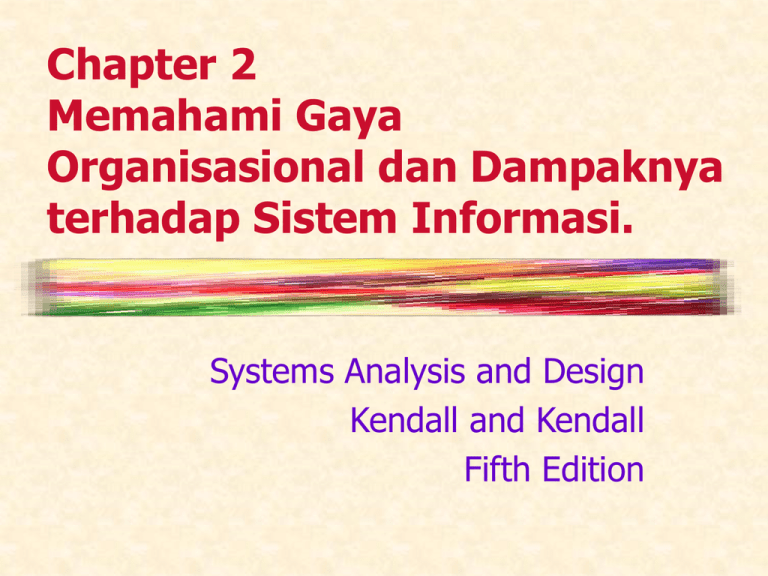
Chapter 2 Memahami Gaya Organisasional dan Dampaknya terhadap Sistem Informasi. Systems Analysis and Design Kendall and Kendall Fifth Edition Major Topics Organizational environment Nature of systems Context-level data flow diagram Entity-relationship diagram Levels of management Organizational culture Kendall & Kendall Copyright © 2002 by Prentice Hall, Inc. 2-2 Organizations Organizations are composed of interrelated and interdependent subsystems System and subsystem boundaries and environments impact on information system analysis and design Kendall & Kendall Copyright © 2002 by Prentice Hall, Inc. 2-3 Organizational Environment Community environment Geographical Demographics (education, income) Economic environment Market factors Competition Political environment State and local government Kendall & Kendall Copyright © 2002 by Prentice Hall, Inc. 2-4 Open and Closed Systems Systems are described as either Open Kebebasan arus informasi Output from one system becomes input to another Closed with restricted access to information Dibatasi dg banyak rules Information on a need to know basis Kendall & Kendall Copyright © 2002 by Prentice Hall, Inc. 2-5 Virtual Organizations A virtual organization has parts of the organization in different physical locations Computer networks and communications technology are used to work on projects Kendall & Kendall Copyright © 2002 by Prentice Hall, Inc. 2-6 Virtual Organization Advantages Advantages of a virtual organization are Reduced costs of physical facilities More rapid response to customer needs Flexibility for employees to care for children or aging parents Kendall & Kendall Copyright © 2002 by Prentice Hall, Inc. 2-7 Enterprise Resource Planning (ERP) Istilah yg digunakan utk menggambarkan sistem informasi organisasional yang terintegrasi. Software dapat membantu dalam flow informasi dalam area fungsional ERP yg tersusun dari Material Requirement (MRP) dirancang untuk meningkatkan manufaktur ERP juga mencakup perencanaan operasi dan penjualan, distribusi, pengelolaan rantai persediaan Kendall & Kendall Copyright © 2002 by Prentice Hall, Inc. 2-8 Menggambarkan Sistem dengan Grafis Context-Level Data Flow Diagram (DFD) Context-level data flow diagram adalah alat penting yang digunakan utk menunjukkan data yg digunakan dan informsaiyang dihasilkan oleh sistem CD menyediakan sebuah overview dari setting atau lingkungan dari sistem : entitas yang memasukkan data dan menerima data/informasi Kendall & Kendall Copyright © 2002 by Prentice Hall, Inc. 2-10 Context-Level DFD Symbols Entity, berupa orang, kelompok, departemen atau sistem yang bisa memberi masukan atau menerima informasi atau data-data awal Penamaan Entity harus kata benda (noun) Customer Kendall & Kendall Copyright © 2002 by Prentice Hall, Inc. 2-11 Context-Level DFD Symbols Process, menggambarkan tindakan atau sekelompok tindakan yg dijalankan Context diagram diberi nomor 0 0 Customer System Kendall & Kendall Copyright © 2002 by Prentice Hall, Inc. 2-12 Context-Level DFD Symbols Data flow, aliran data/informasi yang digambarkan dg anak panah Ini menunjukkan data/informasi yang menuju atau dari proses Penamaan Data flow harus kata benda Passenger Reservation Kendall & Kendall Copyright © 2002 by Prentice Hall, Inc. 2-13 Summary Symbol Kendall & Kendall Copyright © 2002 by Prentice Hall, Inc. 2-14 Menggambarkan Sistem dgn Grafik, contoh (1) Penumpang Data_permintaan Agen Perjalanan Preferensi &infopenerbang an 0 Sistem pemesan an tikel pesawat Info_tiket Tiket pesanan Perusahaan Penerbangan Kendall & Kendall Copyright © 2002 by Prentice Hall, Inc. 2-15 Menggambarkan Sistem dgn Grafik, contoh (2) Packing Slip Purchasing Dept. Supplier 0 Freight Receiving System Source Process Kendall & Kendall Purchase Order Discrepancies Receiving Notice Copyright © 2002 by Prentice Hall, Inc. Accounts Payable System Sink Entity-Relationship Diagrams (E-R Diagrams) Entity-relationship diagrams help the analyst understand the organizational system and the data stored by the organization Digunakan perancang sistem utk membantu pemodelan file & database Symbols are used to represent entities and relationships Kendall & Kendall Copyright © 2002 by Prentice Hall, Inc. 2-17 Entities There are three types of entities: Fundamental entity, describing a person, place, or thing Associative entity, linking entities Attributive entity, to describe attributes and repeating groups Kendall & Kendall Copyright © 2002 by Prentice Hall, Inc. 2-18 Fundamental Entity Describes a person, place, or thing Symbol is a rectangle Patron Kendall & Kendall Copyright © 2002 by Prentice Hall, Inc. 2-19 Associative Entity Joins two entities Can only exist between two entities Symbol is a diamond inside a rectangle Also called a Gerund Junction Intersection Concatenated entity Kendall & Kendall Copyright © 2002 by Prentice Hall, Inc. Reservation 2-20 Attributive Entity Describes attributes and repeating groups Symbol is an oval in a rectangle Performance Kendall & Kendall Copyright © 2002 by Prentice Hall, Inc. 2-21 Relationships Relationships show how the entities are connected There are three types of relationships: One to one One to many Many to many Relationship lines are labeled Kendall & Kendall Copyright © 2002 by Prentice Hall, Inc. 2-22 Relationship Notation One is indicated by a short vertical line Many is indicated by a crows foot Kendall & Kendall Copyright © 2002 by Prentice Hall, Inc. 2-23 Entity Relationship Example Melakukan booking Pelanggan O Konser Melakukan reservasi Kendall & Kendall Copyright © 2002 by Prentice Hall, Inc. 2-24 Pegawai Kantor Sistem Analis Proyek Mesin Pemeliharaan Jadwal Penjual Pelanggan Kendall & Kendall Copyright © 2002 by Prentice Hall, Inc. 2-25 Attributes Data attributes may be added to the diagram Patron Kendall & Kendall Patron Name Patron address Patron phone Patron credit card Copyright © 2002 by Prentice Hall, Inc. 2-26 Creating Entity-Relationship Diagrams Steps menggambar E-R diagrams List daftar entitas dalam organisasi Pilih entitas kunci utk memperkecil scope problem thp dimensi yang ditangani Mengidentifikasi entitas utama seperti apa Konfirmasi hasil-2 tahhap 1 s.d 3 melalui metode pengumpulan data (investigasi, wawancara, kuesioner, observasi, dll) Kendall & Kendall Copyright © 2002 by Prentice Hall, Inc. 2-27 Managerial Control The three levels of managerial control are Operations management Make decisions using predetermined rules Middle management Strategic management Kendall & Kendall Copyright © 2002 by Prentice Hall, Inc. 2-28 Operations Management Make decisions using predetermined rules that have predictable outcomes Work is clear-cut High degree of certainty in decision making Oversee the operating details of the organization Dependent on internal information Kendall & Kendall Copyright © 2002 by Prentice Hall, Inc. 2-29 Middle Management Make short-term planning and control decisions about resources and organizational objectives Experience very little certainty in their decision making Partly operational and partly strategic Dependent on internal information, both historical and prediction oriented Kendall & Kendall Copyright © 2002 by Prentice Hall, Inc. 2-30 Strategic Management Look outward from the organization to the future Make decisions that will guide middle and operations managers Work in highly uncertain decisionmaking environment Define the organization as a whole Dependent on external information Kendall & Kendall Copyright © 2002 by Prentice Hall, Inc. 2-31 Managerial Levels Each of the three levels of management have Different organization structure Leadership style Technological considerations Organization culture Human interaction All carry implications for the analysis and design of information systems Kendall & Kendall Copyright © 2002 by Prentice Hall, Inc. 2-32 Organizational Culture Organizations have cultures and subcultures Learn from verbal and nonverbal symbolism Kendall & Kendall Copyright © 2002 by Prentice Hall, Inc. 2-33 Nonverbal Symbolism Shared artifacts Trophies, etc. Rites and rituals Promotions Birthdays, etc. Clothing worn Office placement and decorations Kendall & Kendall Copyright © 2002 by Prentice Hall, Inc. 2-35
